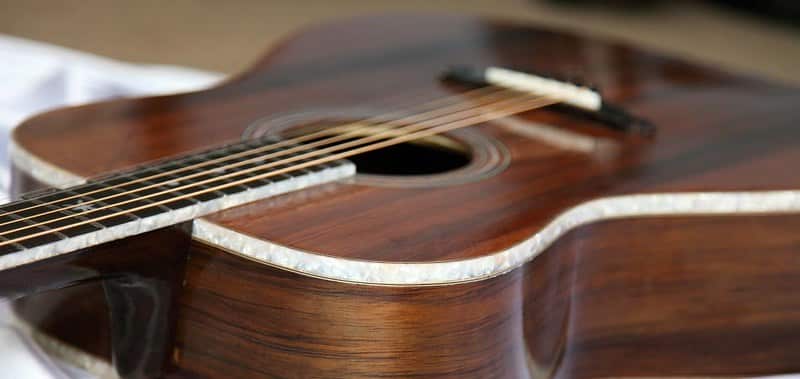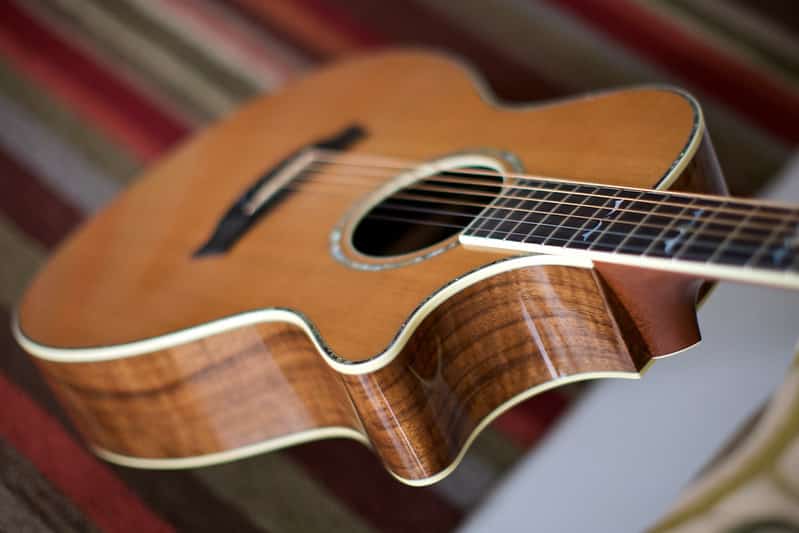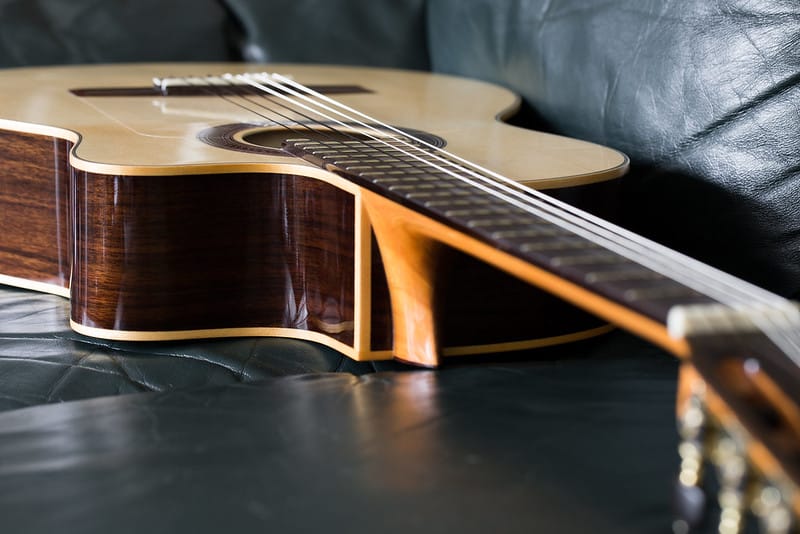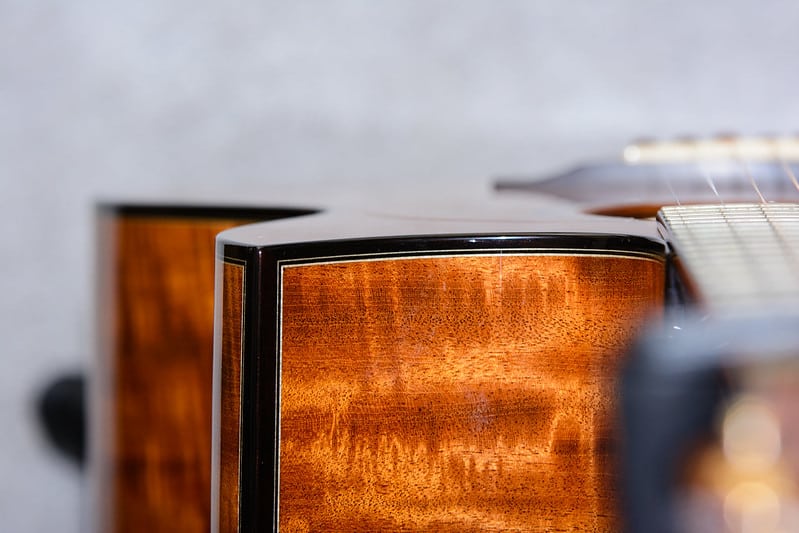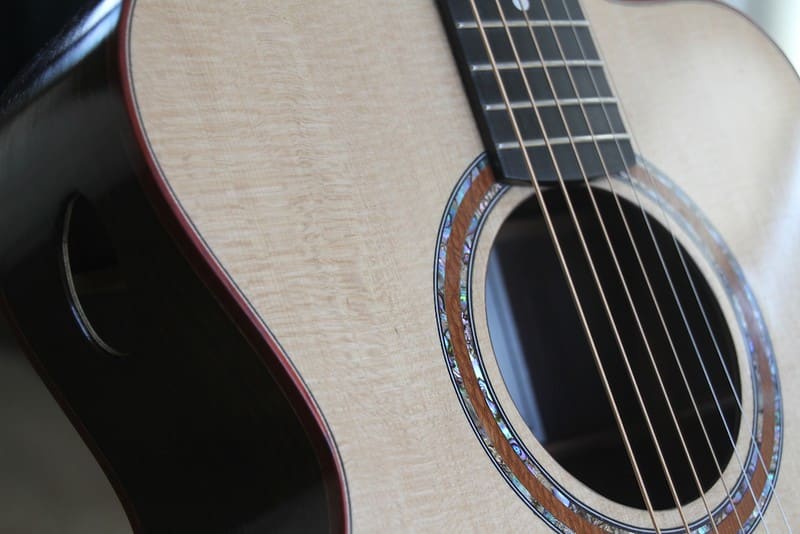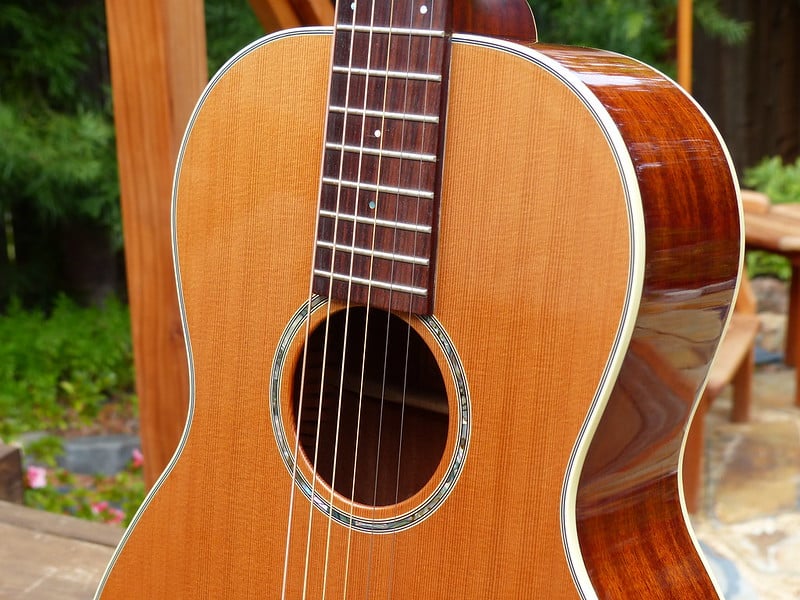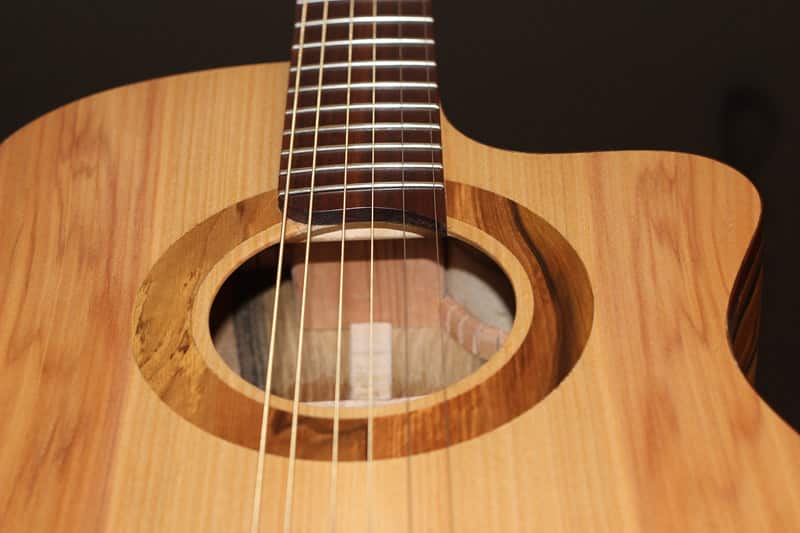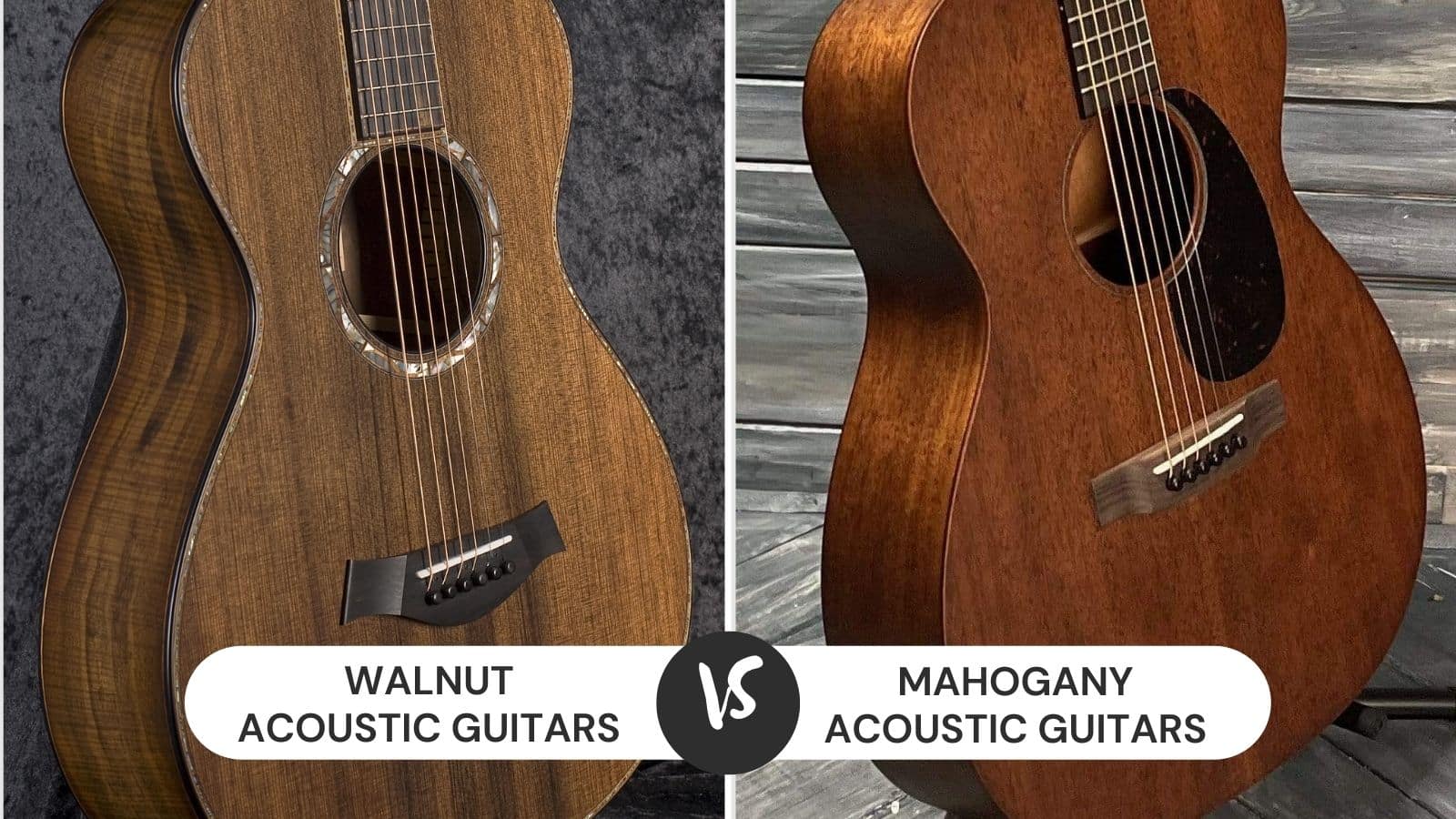
Several materials are being used to manufacture guitars though wood has remained one of the most popular to date. Owing to their durability and availability, wood is often the number one choice when making guitars.
They provide users with a great experience, while also giving them the perfect edge when playing.
Further exploring wood as a raw material for making a guitar, you will find that there are several different types of wood being used to create different types of guitars.
Knowing the type of wood you would need your guitar to be made of can further help you find the right instrument for you.
Walnut and Mahogany are two species of wood most widely used in the manufacturing of acoustic guitars. It can sometimes be quite difficult to tell the difference between the two types of wood as both are of a darker shade.
However, there are some key differences between their characteristics and design aesthetics that vary. It is important to understand the distinct qualities of each as this can help when you are choosing a guitar for yourself.
Walnut vs Mahogany Acoustic Guitars
| QUALITY | WALNUT | MAHOGANY |
|---|---|---|
| Aesthete | Darker and richer tones | Shiny surface |
| Color | Darker wood tones | Ranges from light to dark brown and can include reddish tints. |
| Sound | Blends the warmth of rosewood with the darker tones of mahogany | Produces darker tones that need to be paired with a bright tonewood. |
| Flexibility | Strong but flexible making it ideal to use as tonewood, as well as for the neck and back | Flexible and strong so can be cut thin while still being strong enough to use. |
| Durability | Can last a long time though may require extra care and maintenance | Does not require as much maintenance, some light dusting and wiping. |
| Weight | Lightweight and good for carrying around | Lightweight and good for transporting |
| Customization | Minimal customization | Ideal for making customized guitars, because of their flexibility of sound and durability to take on various guitar body shapes. |
Walnut vs Mahogany Acoustic Guitars
Walnut Acoustic Guitars
Walnut is known for having the perfect balance of a variety of different qualities that you may be looking for in a guitar.
It is noted as having a trait for the best tonality as it produces the perfect tone that blends the mildness of a rosewood acoustic with the darker tones of a mahogany acoustic.
Walnut guitars also have interesting design aesthetics. The guitars are richer and darker in texture which helps enhance the overall vibes and feel of the guitar.
An attractive-looking instrument always adds to the overall confidence and experience of the musician using it.
This acoustic has a density and stiffness to it. It starts with a slightly woodier sound in the beginning but you will find that after playing it for a while, the sound for the lower end tends to fill out.
The materiality of this guitar makes it pretty ideal for a musician to carry around, play, and just generally enjoy the guitar.
It is lightweight, durable, and is a great material to use for acoustic guitars as it enables the instrument to produce beautifully rich tones, something you may have been longing for with other guitars.
Walnut wood is great for creating the tonewood for acoustic guitars. This is thanks to how easy it can bend while also being sturdy and dense.
It also produces a definite tonal quality across the frequency spectrum. It is usually considered the ideal wood for backs and sides and sometimes even necks and fretboards.
Additionally, because walnut produces a low-end midrange response, when combined with a bright top tonewood such as spruce, the produced guitar will give off a balanced sound that is loud yet articulate and classic.
If you are interested in purchasing a walnut acoustic guitar, you are likely to have a wonderful experience.
In addition to its sound quality, the tan and matte texture of the wood is beautiful to look at and will continue to keep the guitar looking good and new for years.
Mahogany Acoustic Guitars
Mahogany is another popular wood type widely known in the production of different guitars. It also has several exciting features like the walnut that may be what you need.
The mahogany is usually used with different types of tonewood within guitars and this allows these instruments to each give off a different and unique sound.
The mahogany and tonewood balance each other out and create a sound that is whole and clear.
The texture of a mahogany guitar is usually shiny which is what makes it quite attractive. Buying one would ensure that you have picked a guitar that has the best design aesthetics.
It also requires minimal care when it comes to making it look nice and that adds to the guitar’s overall appeal.
Normally, you would only need to clean it up with a damp cloth, or gently wipe off any dust or dirt with a soft cloth and the guitar is as good as new.
Additionally, if you keep your guitar in a cloth or hard protective case, you will likely not even have to clean it and the shiny wood will still look as good as new.
The finish on these guitars, which is quite shiny, is advantageous for its owners as it is quite resistant to any sort of dust or dirt particles.
The smooth surface of the wood prevents anything from sticking onto it, making it quite an easy instrument to care for and look after.
It also means that these kinds of guitars are great for outdoor or public performances where you wouldn’t need to worry much about your guitar.
Besides being shiny, mahogany also comes in a variety of brown shades that range from a light brown to a darker one. It can also sometimes feature a slightly red tone.
As a tonewood, mahogany can create a more resonant tone that can last for a much longer time. Musicians find that their guitar tones are quite balanced for a longer time as compared to guitars with other tonewoods.
Mahogany guitars usually produce a warmer sound. The wood itself is very lightweight and flexible and therefore, makes the guitars easy to move around or carry everywhere.
This makes them greater for guitarists that do not work in a studio but rather need to move around from place to place to play.
The major reason that mahogany has been used as part of guitars for so long is because of its durability and versatility. It also can provide the perfect mixture of sound.
The mahogany acoustic guitar will usually have a thick bottom end and a controlled high end while having a perfect midrange.
It can perfectly balance all kinds of sound and its various ranges, and is, therefore, used vastly as a wood type for creating customized guitars.
It is suitable to fit most guitar players as it can create several guitar body shapes and has the best sound.
What Are Other Types Of Wood Used For Making Guitars?
There are a variety of wood types that are used in the guitar-making process and with each wood, you will receive distinct advantages and a distinct sound.
Basic or entry-level guitars are usually made from laminated wood which does not change or mature, they stay the same always.
Guitars that can be used by intermediate players are a mixture of solid wood tops which are combined with laminated wood on the back and sides.
Professional guitars are therefore made of solid wood which eventually matures and age and produce the richest and most resonant sound among all three types of guitars.
Guitar tops can be seen most commonly made of spruce or cedar. On the other hand, wood types that are standard for the back and sides of a guitar are rosewood, maple, and mahogany.
You may also find that synthetic materials are added to the creation of guitars by some companies.
Spruce
This is one of the most common types of wood used for the guitar top of an acoustic instrument. The strength to weight ratio of the material makes it ideal to produce a top that is thin but still sturdy and impactful.
They can take a decent amount of damage to them and can still be responsive if played very hard. Spruce is a great material for those interested in strumming or Flatpicking.
Cedar
This is a slightly darker color than spruce and has a slight reddish tint. Unlike the spruce, cedar responds better to a gentle touch and is, therefore, ideal for fingerpicking.
It is a comparatively softer wood and can be worn out if overplayed and not properly cared for.
Rosewood
This is a dark wood type and gives off a warm and rich tone to its guitars. It is quite a sort after wood type, especially the Brazilian rosewood but because of its scarcity, it can be quite expensive.
Maple
This produces a dry tone, which is still bright and clear, as well as well-defined. It can also sometimes be quite dramatic and is exciting to listen to when being used in a performance.


